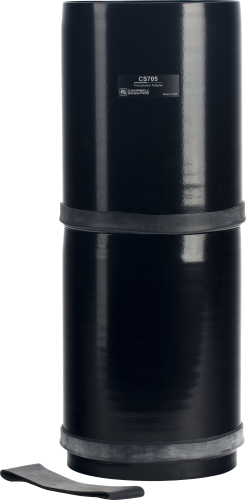
不需加热的熔雪






概览
The CS705 is a snowfall adapter that converts a standard 8 in. tipping bucket rain gage to a year-round rain and snow gage. It is typically used with our TE525WS rain gages.
The CS705 consists of the following:
- One black catch tube
- One reservoir
- One overflow (measurement) tube
- One 14807 drain funnel
- Two stainless-steel band clamps
- One set of CM270 mounting hardware
Solid precipitation is gathered in the catch tube and mixed with a non-toxic propylene glycol and ethanol (PGE) solution inside the reservoir. The PGE solution lowers the melting point of the frozen snow and allows the resulting liquid solution to flow through the overflow tube and be measured with a standard 8 in. rain gage.
优势与特点
- Melts snow without a heater and therefore eliminates the current consumption associated with heaters
- Converts a TE525WS to a rain and snow gage
- Collects PGE/precipitation mixture below the rain gage for disposal according to local requirements
图像









技术说明
CS705含有盛防冻剂的水箱、溢流管和集雪管。落入集雪管的雪花被融雪剂融化,增加了水溶液的水位,混合的水溶液通过溢流管流到翻斗上,产生可测量的开关脉冲信号。
测量延时
CS705的处理过程会有延时,不适合实时的降水测量。以下的因素会导致延时:
- 空气和水箱液体的温度
- 溢流管的表面张力
- 降水的形式
对于 25°C下的降水,在雨量筒收集了最小 ~0.03英寸的累积量之后,预计会有数分钟的延时。对于下雪的情形,预计测量会有几小时到十几小时的延时。在极低气温下的低强度降雪,可能会有最长的测量延时。不过,落入集雪管的所有降水最终都会流过溢流管,并被雨量筒的翻斗所测量。
Recommended Mixture
The CS705 requires a specific 1:1 formulation of propylene glycol and ethanol (PGE) to function properly. PGE is available from Campbell Scientific in a package of four, one-gallon containers (see Ordering Information). Due to regulatory restrictions, PGE can only be shipped in multiples of four gallons via UPS Ground and cannot be shipped outside of the continental US.
Why Straight Car or RV Antifreeze is NOT Recommended
Standard RV antifreeze consist of propylene glycol or ethylene glycol, which has a specific gravity of greater than 1. This allows a layer of water to sit on top of the antifreeze. That layer of water can then freeze and form an ice cap that prevents snowfall from being dissolved in the solution. Cutting the antifreeze with ethanol solves the specific gravity issue and prevents the ice cap. PGE is also more environmentally friendly.
Disposing of PGE Mixture
Although PGE is non-toxic, the PGE/precipitation mixture from the tipping bucket gage should be captured and disposed of properly in accordance with local, state, and federal regulations.
产品规格
| Compatible Antifreeze Mixture |
1:1 mixture of propylene glycol and ethanol (PGE) Campbell Scientific does not recommend using the antifreeze that is typically used in cars or RVs; refer to the Compatibility section for more information. |
| Material | Powder-coated aluminum |
| Capacity | 20.3 cm (8 in.) of liquid @ -20°C (assuming 1:0 starting ratio of antifreeze to water) |
| PGE Reservoir Capacity | 9.46 L (2.5 gal) |
| PGE Reservoir Diameter | 20.96 cm (8.25 in.) |
| PGE Reservoir Height | 35.6 cm (14 in.) |
| Catch Tube Orifice | 20.3 cm (8 in.) |
| Catch Tube Height | 25.4 cm (10 in.) |
| Weight |
|
兼容性
Tipping Bucket Rain Gages
The CS705’s specially shaped cylinder allows it to mount to the 8-in. orifice of the TE525WS Tipping Bucket Rain Gage. The CS705 cannot be directly used with the TE525, TE525MM, CS700, TB4, or TB4MM tipping bucket rain gages.
Mounting
The CM270 Mounting Kit is included with each purchase of the CS705 Snowfall Adapter. The kit consists of a funnel, two band clamps, and mounting hardware. The funnel drains the antifreeze/precipitation mixture into a pail. One of the band clamps secures the top of the CS705 to a pole. The other band clamp attaches the funnel and the bottom of the rain gage to the pole.
A user-supplied pole or a CM300-series mounting pole may be used. The user must provide a pail and a hose with a 0.5 in. inner diameter. The hose must be long enough to span the distance from the funnel outlet to the pail.
相关技术文档
常见问题解答
CS705: 4
展开全部收起全部
-
Yes. Mixed rain and snow does not cause any issues for the CS705.
-
The CS705 works with the TE525WS-L rain gage.
-
Generally, the antifreeze is changed after 8 inches of liquid water have been added to the antifreeze/ethanol mixture. Eight inches of water will dilute the antifreeze/ethanol mixture to the point where freezing will occur at -20 degrees Celsius.
-
The CS705 Tipping Bucket Snowfall Adapter cannot be used directly with the TE525-L or TE525MM-L because of the funnel size. To make the rain gages compatible, they can either be sent to Campbell Scientific to be converted to a TE525WS-L, or an 8 inch funnel can be installed. If the funnel is used, see the instruction manual for the appropriate multipliers, as they will change.